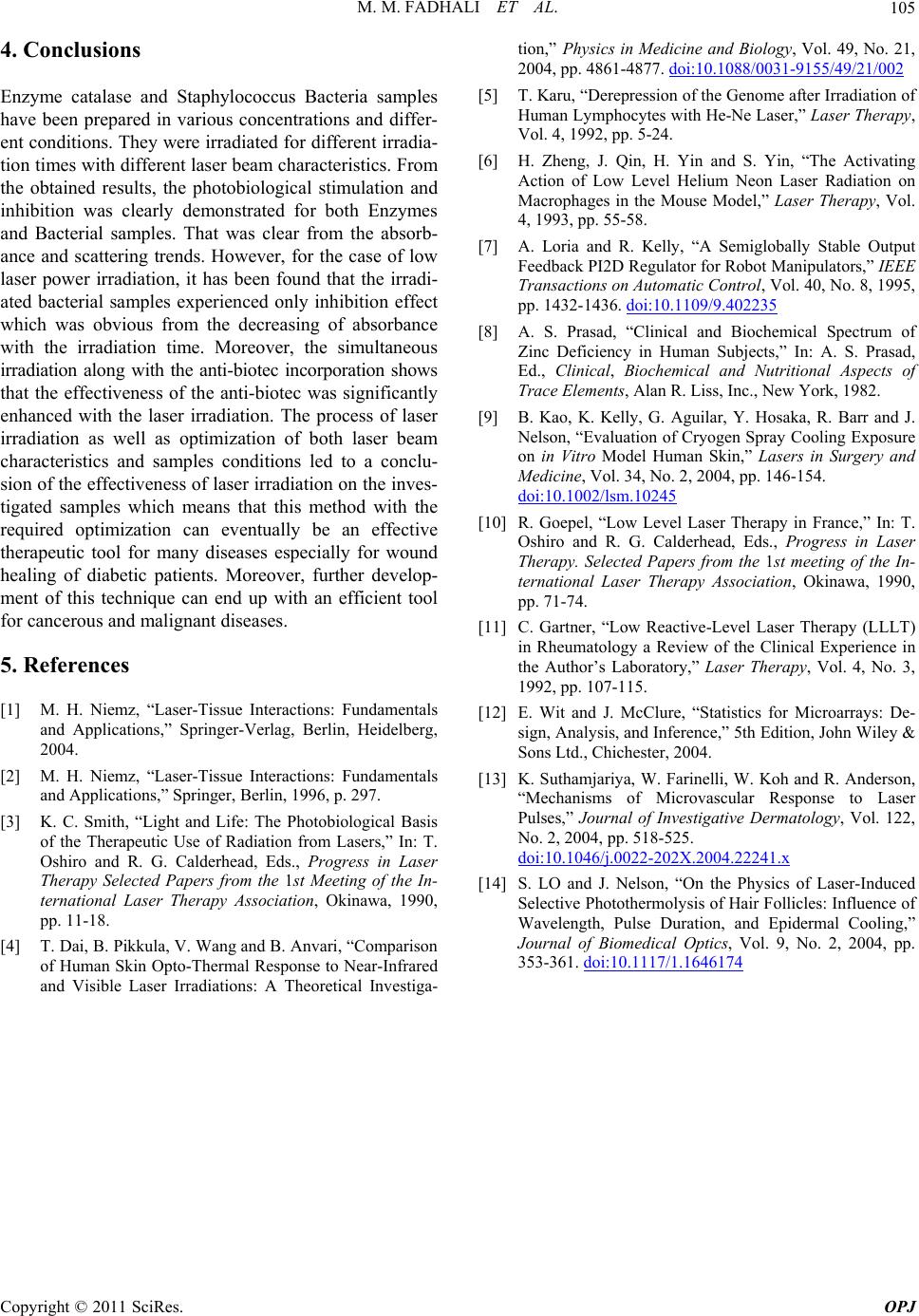
M. M. FADHALI ET AL.
Copyright © 2011 SciRes. OPJ
105
4. Conclusions
Enzyme catalase and Staphylococcus Bacteria samples
have been prepared in various concentrations and differ-
ent conditions. Th ey were irradiated for different irradia-
tion times with different laser beam characteristics. From
the obtained results, the photobiological stimulation and
inhibition was clearly demonstrated for both Enzymes
and Bacterial samples. That was clear from the absorb-
ance and scattering trends. However, for the case of low
laser power irradiation, it has been found that the irradi-
ated bacterial samples experienced only inhibition effect
which was obvious from the decreasing of absorbance
with the irradiation time. Moreover, the simultaneous
irradiation along with the anti-biotec incorporation shows
that the effectiveness of the anti-biotec was significantly
enhanced with the laser irradiation. The process of laser
irradiation as well as optimization of both laser beam
characteristics and samples conditions led to a conclu-
sion of the effectiveness of laser irradiation on the inves-
tigated samples which means that this method with the
required optimization can eventually be an effective
therapeutic tool for many diseases especially for wound
healing of diabetic patients. Moreover, further develop-
ment of this technique can end up with an efficient tool
for cancerous and malignant diseases.
5. References
[1] M. H. Niemz, “Laser-Tissue Interactions: Fundamentals
and Applications,” Springer-Verlag, Berlin, Heidelberg,
2004.
[2] M. H. Niemz, “Laser-Tissue Interactions: Fundamentals
and Applications,” Springer, Berlin, 1996, p. 297.
[3] K. C. Smith, “Light and Life: The Photobiological Basis
of the Therapeutic Use of Radiation from Lasers,” In: T.
Oshiro and R. G. Calderhead, Eds., Progress in Laser
Therapy Selected Papers from the 1st Meeting of the In-
ternational Laser Therapy Association, Okinawa, 1990,
pp. 11-18.
[4] T. Dai, B. Pikkula, V. Wang and B. Anvari, “Comparison
of Human Skin Opto-Thermal Response to Near-Infrared
and Visible Laser Irradiations: A Theoretical Investiga-
tion,” Physics in Medicine and Biology, Vol. 49, No. 21,
2004, pp. 4861-4877. doi:10.1088/0031-9155/49/21/002
[5] T. Karu, “Derepression of the Genome after Irradiation of
Human Lymphocytes with He-Ne Laser,” Lase r Therapy,
Vol. 4, 1992, pp. 5-24.
[6] H. Zheng, J. Qin, H. Yin and S. Yin, “The Activating
Action of Low Level Helium Neon Laser Radiation on
Macrophages in the Mouse Model,” Laser Therapy, Vol.
4, 1993, pp. 55-58.
[7] A. Loria and R. Kelly, “A Semiglobally Stable Output
Feedback PI2D Regulator for Robot Manipulators,” IEEE
Transactions on Automatic Control, Vol. 40, No. 8, 1995,
pp. 1432-1436. doi:10.1109/9.402235
[8] A. S. Prasad, “Clinical and Biochemical Spectrum of
Zinc Deficiency in Human Subjects,” In: A. S. Prasad,
Ed., Clinical, Biochemical and Nutritional Aspects of
Trace Elements, Alan R. Liss, Inc., New York, 1982.
[9] B. Kao, K. Kelly, G. Aguilar, Y. Hosaka, R. Barr and J.
Nelson, “Evaluation of Cryogen Spray Cooling Exposure
on in Vitro Model Human Skin,” Lasers in Surgery and
Medicine, Vol. 34, No. 2, 2004, pp. 146-154.
doi:10.1002/lsm.10245
[10] R. Goepel, “Low Level Laser Therapy in France,” In: T.
Oshiro and R. G. Calderhead, Eds., Progress in Laser
Therapy. Selected Papers from the 1st meeting of the In-
ternational Laser Therapy Association, Okinawa, 1990,
pp. 71-74.
[11] C. Gartner, “Low Reactive-Level Laser Therapy (LLLT)
in Rheumatology a Review of the Clinical Experience in
the Author’s Laboratory,” Laser Therapy, Vol. 4, No. 3,
1992, pp. 107-115.
[12] E. Wit and J. McClure, “Statistics for Microarrays: De-
sign, Analysis, and Inference,” 5th Edition, John Wiley &
Sons Ltd., Chichester, 2004.
[13] K. Suthamjariya, W. Farinelli, W. Koh and R. Anderson,
“Mechanisms of Microvascular Response to Laser
Pulses,” Journal of Investigative Dermatology, Vol. 122,
No. 2, 2004, pp. 518-525.
doi:10.1046/j.0022-202X.2004.22241.x
[14] S. LO and J. Nelson, “On the Physics of Laser-Induced
Selective Photothermolysis of Hair Follicles: Influence of
Wavelength, Pulse Duration, and Epidermal Cooling,”
Journal of Biomedical Optics, Vol. 9, No. 2, 2004, pp.
353-361. doi:10.1117/1.1646174